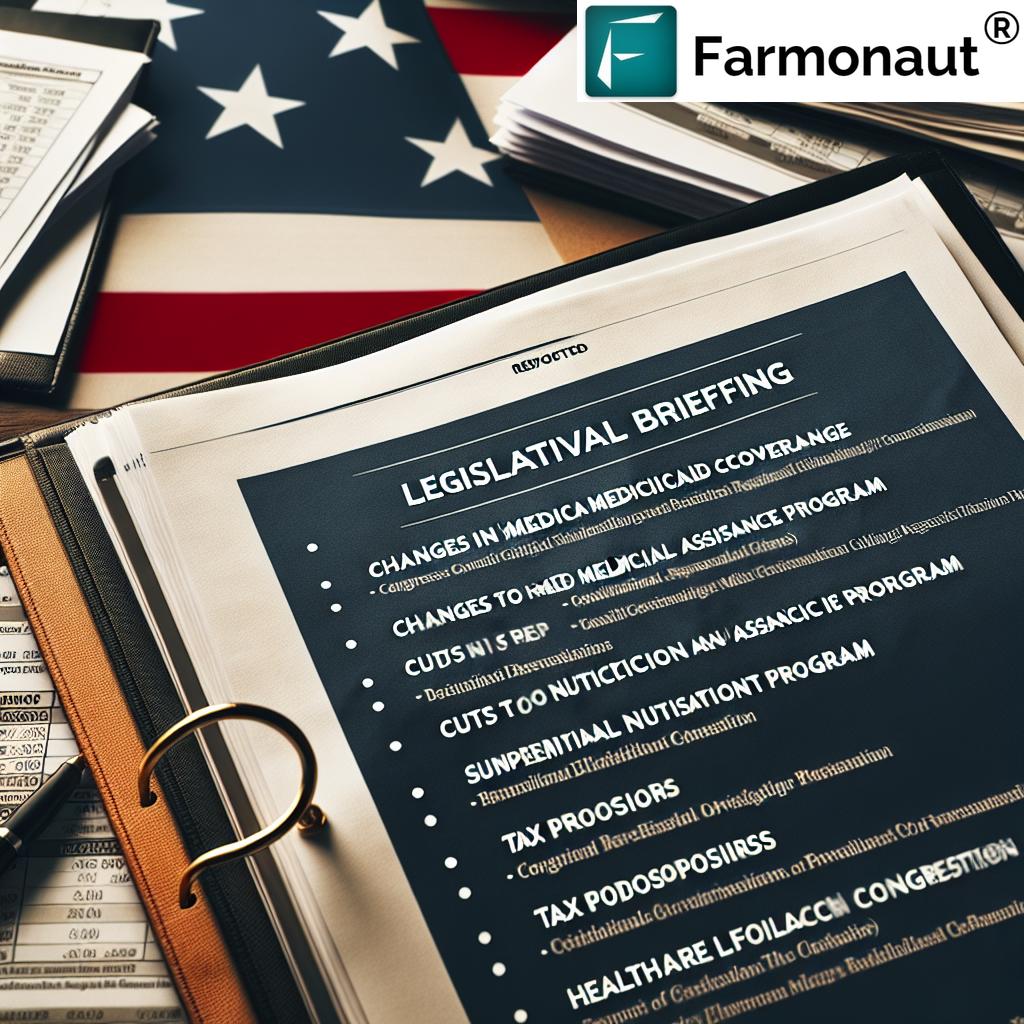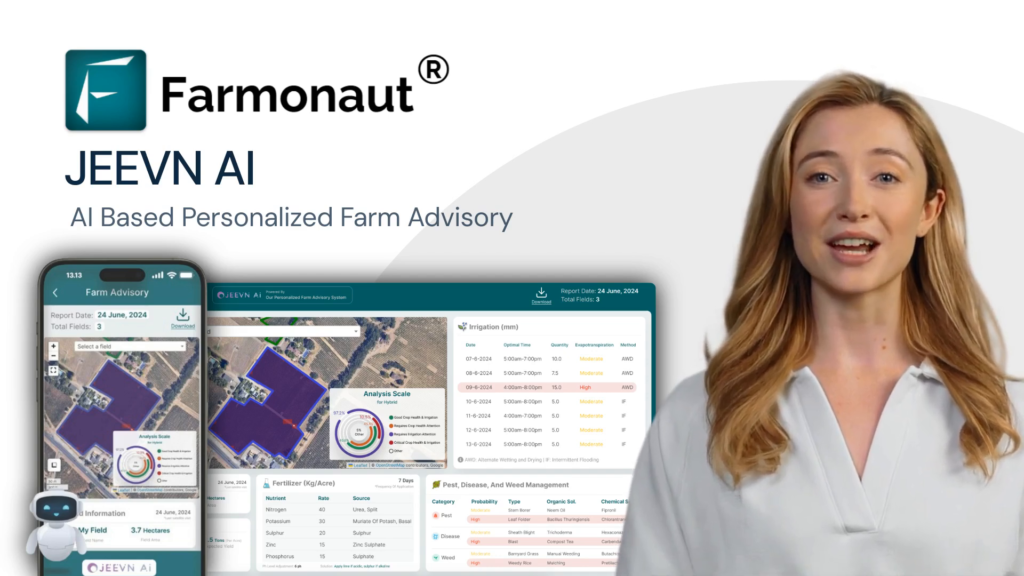New York Federal Spending Cuts: 5 Powerful Changes in GOP Plan
Table of Contents
- Essential Trivia: Money & Impact
- Federal Spending Cuts: A Turning Point in New York Policy
- Comparative Impact Summary Table
- Tax Proposal Debate Heats Up
- Medicaid Work Requirements: Rewriting Access
- Energy Program Funding and Environmental Policy
- State and Local Tax Cap Controversies
- Supplemental Nutrition Assistance Program Cuts & Agriculture
- Internal GOP Dynamics and Legislative Path Forward
- How Farmonaut Empowers Agriculture Amid Federal Policy Shifts
- Frequently Asked Questions
“The GOP plan proposes over $130 billion in federal spending cuts, impacting Medicaid and energy program funding in New York.”
Federal Spending Cuts: A Turning Point in New York Policy
As the U.S. Congress advances toward a crucial vote on sweeping federal spending cuts, the state of New York finds itself at the epicenter of profound legislative changes. The latest GOP plan in the House not only proposes dramatic reductions to core federal programs, but also introduces targeted healthcare policy legislation, contentious tax proposal debate, an overhaul of energy program funding, and reforms that will affect states from policy to budgetary execution.
In this comprehensive analysis, we will:
- Dissect the five most powerful policy shifts in the House Republican spending plan
- Explore Medicaid work requirements, new eligibility rules, and cap changes
- Analyze the impact of the state and local tax cap on New York taxpayers
- Review how energy funding and environmental law changes may alter the state’s future
- Connect evolving agricultural challenges to the future of technology, like Farmonaut’s innovations
With billions in proposed government spending reductions, debate in Congress and among key lawmakers has reached a new peak. The implications—in areas like healthcare, energy, and agriculture—will reverberate across public services, the state budget, and strategies pursued by businesses and technology providers. As stakeholders and citizens, we must understand both the legislative mechanics and the big-picture impacts for New York and beyond.
Comparative Impact Summary Table: Top 5 Federal Spending Cuts and Legislative Changes
| Change Area | Description of Proposed Change | Estimated Budget Impact (USD Billions, 10 Years) | Affected Stakeholders | Projected Timeline for Implementation |
|---|---|---|---|---|
| Medicaid Work Requirements & Coverage Changes | Nationwide work requirements for able-bodied adults; more frequent eligibility checks; funding penalties for states covering undocumented immigrants. | $880+ (shared with Energy, see #2) | Medicaid enrollees in NY (esp. 19–65 yrs), state agencies, low-income/immigrant families, health providers | 2025–2034, work requirements phased in over months |
| Energy Program Funding Cuts | Repeal of sections of the Inflation Reduction Act; removal of clean-energy tax credits, Greenhouse Gas Reduction Fund, DOE clean energy loans. | Included in $880+ (w/ Medicaid) | States with green initiatives (New York included), energy sector businesses, consumers, climate program staff | 2025–2027, immediate program rollbacks |
| Tax Proposal Debate: Cuts/Expansions & SALT Cap | Extends Trump-era tax law; increases SALT cap to $30,000, higher standard deduction/child tax credit, temporary no-tax-on-tips, car loan interest exemption. | $4000+ (for full Trump tax cut extension, estimate) | Taxpayers in NY & high-tax states, moderate/high earners, married filers, service workers receiving tips | 2025–2029 (most provisions), phases begin in 2025 |
| Supplemental Nutrition Assistance Program (SNAP) Cuts | $230+ billion in agriculture/farm bill savings, restructuring SNAP eligibility and benefit formulas. | $230+ | SNAP recipients, low-income families, rural/agricultural support organizations | 2025–2034, subject to USDA rulemaking timelines |
| Debt Limit & Reconciliation Legislation Congress Strategy | Bundled debt ceiling increase with spending cuts to bypass 60-vote Senate filibuster, enabling passage by simple majority. | — (indirect fiscal impact, not a direct spending cut) | Federal government, all states, credit markets, executive leadership | Pre-August 2025 deadline, depending on GOP agreement |
Tax Proposal Debate Heats Up: SALT Cap and Extension of Federal Tax Cuts
A central pillar of the GOP plan involves a sweeping tax proposal debate—one that affects both New York’s high-tax districts and millions of American households. The legislation would extend the 2017 federal tax law, temporarily raise child tax credits, and slightly ease the controversial State and Local Tax Deduction (SALT) cap to $30,000.
The Stakes for New Yorkers: SALT Cap and Taxpayer Impact
At the heart of this discussion is the adjustment of the state and local tax cap. With the cost difference between federal receipts and outlays hitting New York especially hard, legislators are debating whether the new $30,000 cap goes far enough.
- New York House Republicans contend this level is insufficient, noting that constituents already pay substantially more to the federal government than they receive in services.
- Moderate GOP lawmakers from high-tax states insist that support for the package hinges on adequate SALT cap relief.
- The provision’s fate could determine the overall support among crucial swing-district members and whether the legislation advances to the Senate.
Beyond the tax proposal debate, key other changes include:
- Higher standard deduction until 2029—potentially up to $2,000 more for single filers
- Increase to child tax credit: from $2,000 to $2,500, with a refundable portion up to $1,400 per child
- No tax on tips provision, but only through 2028, targeting service workers, provided both they and their spouses supply valid SSNs
- No car loan interest tax on U.S.-assembled vehicles through 2028
The cost of these changes is large: Deficit watchdogs estimate an extension of the 2017 law could cost more than $4 trillion over ten years—posing a significant challenge for lawmakers who support both deficit reduction and middle-class tax relief.
For policymakers, balancing New York’s need for fair federal tax treatment with national fiscal constraints remains a central challenge as the tax proposal debate continues.
Focus on Medicaid Work Requirements: Changing Health Coverage
The proposed Medicaid work requirements and coverage changes represent one of the most controversial elements of the house republican spending plan. With Medicaid enrollment accounting for millions of New Yorkers—especially the working poor, families with children, adults with disabilities, and immigrants—new requirements stand to reshape access to care and eligibility for many.
What Are the New Requirements?
- Work/Activity Mandate: All able-bodied adults aged 19–65 (with exemptions for parents of dependents, pregnant people, enrollees with disabilities or serious conditions) must now work, do community service, or enroll in education for at least 80 hours per month.
- Eligibility Checks: States must check all Medicaid enrollees’ eligibility every six months (instead of annually for ACA expansion populations).
- Penalties for States Covering Undocumented Immigrants: States offering Medicaid to undocumented immigrants—including New York—face reduced federal funding (from 90% to 80% for expansion populations), unless they change their inclusion policies.
Projected Impacts for New York
- Millions at Risk: Congressional Budget Office (CBO) and Democratic lawmakers warn of potential Medicaid loss for millions—up to 1.5 million New Yorkers are at risk under new requirements.
- Administrative Burden: Six-month eligibility checks increase workload for state Medicaid agencies, raising the risk of errors or inadvertent disenrollment of eligible enrollees.
- Access Concerns: Critics note that these provisions could create confusion, loss of healthcare coverage, and increased hardship, especially for borderline-eligible families and people with complex situations.
Supporters, led by Kentucky Republican Rep. Brett Guthrie, insist these changes will encourage workforce participation, end “wasteful spending,” and “strengthen Medicaid for mothers, children, individuals with disabilities, and the elderly.” However, a significant block of both progressive and far-right representatives continue to debate the ethics, cost, and politics.
“Medicaid work requirements could affect up to 1.5 million New Yorkers under the new federal legislative proposals.”
Medicaid Coverage Changes and the Future of Healthcare Policy Legislation
As healthcare policy legislation evolves, the intersection of work requirements, state funding, and demographic realities will shape not only access but also the structure of care networks in New York and similar states.
Energy Program Funding: Repealing Clean Energy Initiatives
Among the boldest moves in the GOP plan is a dramatic reduction in energy program funding—particularly policies aimed at combatting climate change and driving a clean energy transition. Several critical provisions of President Biden’s Inflation Reduction Act would be reversed or rescinded, impacting New York’s ambitious environmental roadmap and the nation’s climate leadership.
- Elimination of Greenhouse Gas Reduction Fund: Strips $27 billion earmarked for financing state and municipal clean energy projects.
- Repeal of DOE Clean Energy Loan Programs: Discontinues $40 billion in low-interest loans for clean infrastructure buildout.
- Rescission of Unspent Program Funds: Pulls unused awards for carbon reduction, coastal resilience, air pollution, offshore wind transmission, and related clean investment efforts.
- Expedited Pipeline Approvals: Allows pipeline developers to pay the government for bypassing environmental reviews—potentially accelerating fossil fuel projects and reducing public oversight.
What This Means for New York
- New York, as a state with aggressive green targets, stands to lose future federal funding that supports energy affordability, job creation, and renewable business growth.
- Climate organizations and distributed energy businesses see rollbacks as threats to both state development and long-term cost savings for consumers.
As Rep. Kathy Castor observed: “Cleaner, cheaper energy for consumers gets left behind… Dismantling our landmark Inflation Reduction Act will kill jobs, hurt businesses, and drive-up Americans’ energy costs.” The energy program changes reflect the intense partisan debate over federal government priorities, balancing deficit reduction against economic and environment transformation.
For agribusiness, such as those using Farmonaut’s carbon footprinting tools, proposed changes raise important questions about long-term incentives for sustainable farming and supply chain transparency.
Controversy over State and Local Tax Cap (“SALT”)
Debate over the state and local tax cap within the tax proposal remains among the most divisive issues in Congress. Established in 2017 at $10,000, the cap significantly limits federal deductibility for high-tax-state residents, especially in New York. The GOP plan suggests a temporary raise to $30,000—but given New York’s average tax bills, even this increase is met with skepticism.
- Several New York reps, including Rep. Nick LaLota, have publicly rejected the plan: “Still a hell no.”
- Claims of fairness drive ongoing negotiation, with calls for the GOP leaders to secure concessions that benefit large, urban states.
- Whether the proposal will win over the necessary support is uncertain, jeopardizing not only the SALT cap provision but also the fate of the entire reconciliation package.
This underscores the complex tug-of-war between federal deficit management and equity for states like New York, where the federal tax burden outpaces federal support levels.
Agriculture and Supplemental Nutrition Assistance Program (SNAP) Cuts
The House Agriculture Committee targets at least $230 billion in savings over ten years in its segment of the reconciliation bill, with changes likely centered on the Supplemental Nutrition Assistance Program (SNAP).
Key Provisions and Impact
- Specific details of SNAP adjustments remain pending as of the latest markup, but expectations point to tightened eligibility and possible benefit reductions.
- The farm bill, traditionally a bipartisan effort, may spark significant disagreement if spending reductions are perceived as undermining food security or rural investment.
- Changes will directly affect low-income households and rural/agricultural support structures in New York.
On the technology and sustainability side of agriculture, New York’s farmers and cooperatives are increasingly turning to precision management solutions like Farmonaut’s large-scale farm management platform—optimizing costs and improving yields in an environment of resource uncertainty.
Are you an agri-business or farming cooperative? Optimize your fleet and resource management with satellite and AI-driven insights for smarter cost control.
Internal GOP Dynamics, Legislative Trends and the Road to Senate Approval
With razor-thin majorities in the House and Senate, every vote—and every amendment—matters. The divided GOP conference is managing tension between centrists (concerned about Medicaid and SALT cap fairness) and hard-right lawmakers (opposed to any residual increases in the debt or perceived benefits to “corrupt blue states”).
- Competing amendments are expected in both tax and Medicaid spending provisions, potentially shifting key details before a final vote.
- If delays or defections emerge, a broader bipartisan agreement on the federal debt limit may become necessary—requiring more compromise and further stalling key GOP priorities.
- If passed in the House, the legislative package then faces the Senate, where several critical provisions (e.g., Medicaid and energy) could be reworked or stripped altogether.
Looking ahead, the future of reconciliation legislation Congress is uncertain. The next several months will reveal whether these federal spending cuts, healthcare legislation, and tax debates define a new direction for fiscal policy or simply open broader rifts within and between the major parties.
How Farmonaut Empowers Agriculture Amid Federal Policy Shifts
As New York and other states navigate the uncertainties of federal funding and policy, Farmonaut provides vital technological solutions to manage agricultural risks, optimize productivity, and build supply chain resilience:
- Satellite-Based Crop Health Monitoring: Real-time imagery guides time-critical care and resource management, helping farms weather financial shocks and focus inputs where ROI is highest.
- Jeevn AI Advisory: Precision forecasts and AI-driven recommendations allow New York growers to adapt to regulatory or environmental changes quickly.
- Blockchain-Based Traceability: As markets demand greater supply chain transparency, Farmonaut’s blockchain integration provides end-to-end traceability.
- Fleet and Resource Management: Satellite-enabled fleet tracking reduces operational costs and enhances compliance, a must in a cost-cutting environment.
- Carbon Footprinting: For farms facing new environmental reporting requirements or participating in emissions reduction initiatives, this tool quantifies impact and supports sustainable practice adoption.
Want even deeper integration? Use the Farmonaut Satellite API for programmatic access, or view the latest API Developer Docs for advanced applications.
For those seeking greater financial flexibility, Farmonaut also supports crop loan and insurance verification with reliable, satellite-based evidence, improving access to credit and risk reduction.
Explore Forest, Plantation, and Crop Advisory with integrated climate insights: start here.
Frequently Asked Questions (FAQ): New York Federal Spending Cuts & Policy Changes
1. What are the major components of the New York federal spending cuts in the GOP plan?
The top five policy shifts include: Medicaid work requirements and coverage changes, repeal of major energy program funding under the Inflation Reduction Act, adjustments to the state and local tax (SALT) cap, significant changes to the Supplemental Nutrition Assistance Program (SNAP), and bundling these moves with a debt limit increase via the reconciliation process.
2. Who will be most affected by new Medicaid work requirements?
Able-bodied adults ages 19–65 in New York and other states, especially those without dependents or exceptions. Families with intermittent employment and immigrants may also see additional administrative hurdles, with up to 1.5 million New Yorkers potentially affected.
3. How does the state and local tax cap (SALT) change?
The cap increases temporarily from $10,000 to $30,000 under the proposed legislation, but this is still considered insufficient by many New York lawmakers and may jeopardize passage unless further adjustments are made.
4. What’s changing in federal energy program funding?
The plan revokes funding for key clean energy and climate initiatives, eliminating federal support for programs that drive renewable investment and environmental resilience, including those that benefited New York.
5. Will SNAP recipients in New York see immediate changes?
Details are still being finalized, but proposed $230+ billion in spending cuts could lead to stricter eligibility and reduced benefits for SNAP participants over the next decade.
6. How will agricultural businesses adapt?
Many are turning to advanced technologies like Farmonaut’s satellite monitoring and AI-based advisory systems to improve efficiency, cut costs, and maintain compliance amid shifting federal policy landscapes.
7. What is the legislative path forward for this package?
After committee markups, the House must approve the full package, followed by possible Senate amendments. The process is highly sensitive to internal party dynamics and bipartisan negotiations, especially regarding debt limit language.
8. How can I get more information or access Farmonaut’s solutions?
See detailed product portfolios and use cases at Carbon Footprinting, Fleet Management, and our integrated crop advisory app. For APIs, visit the API page and Developer Docs.
Conclusion: Navigating Unprecedented Change in Federal Spending and Policy
The New York federal spending cuts reflected in the current GOP plan mark a crossroads in the ongoing debate over state needs, fiscal responsibility, and innovative recovery. Policymakers and impacted sectors must work together—marrying technology, strategic management, and advocacy—to secure a future that balances budget, access, and sustainability.
At Farmonaut, we remain dedicated to empowering stakeholders in agriculture and beyond with affordable, real-time decision-making tools as they navigate shifting legislative and economic realities. For full feature lists and real-time demos, visit our carbon footprinting, blockchain traceability, and large-scale management product pages.

















